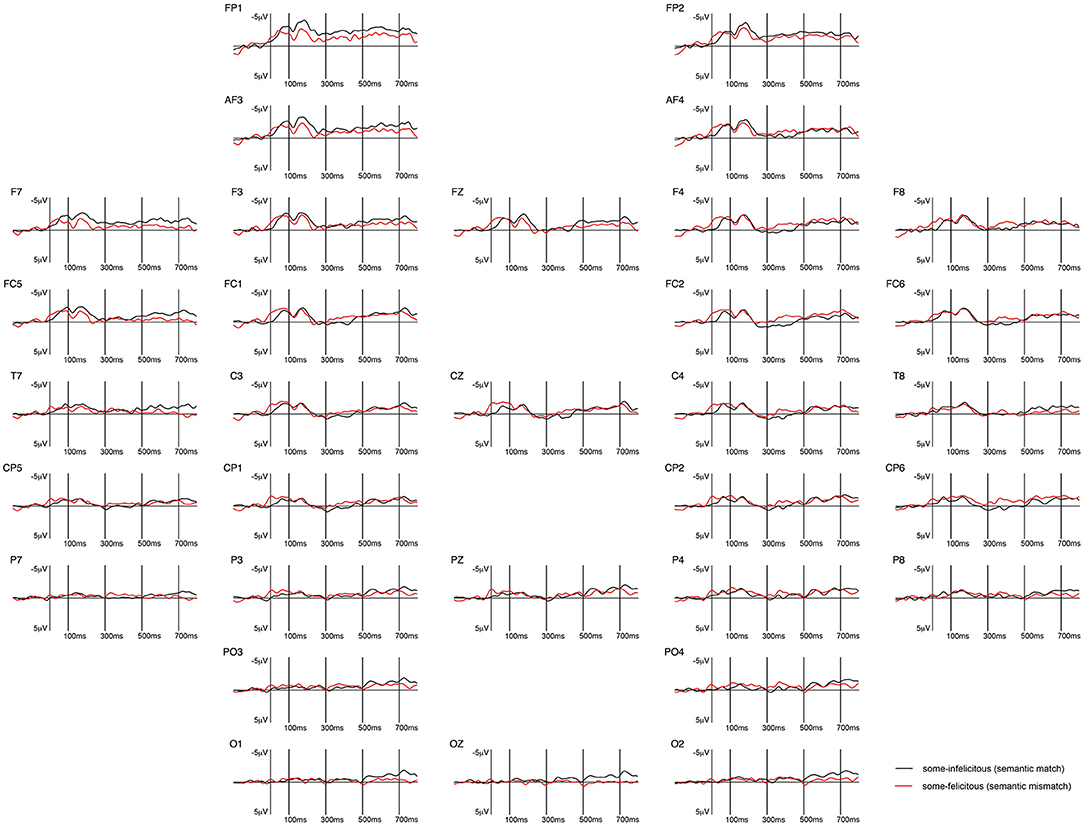
94% of researchers rate our articles as excellent or good
Learn more about the work of our research integrity team to safeguard the quality of each article we publish.
Find out more
CORRECTION article
Front. Psychol. , 10 November 2021
Sec. Cognitive Science
Volume 12 - 2021 | https://doi.org/10.3389/fpsyg.2021.777595
This article is a correction to:
Early ERP Evidence for Children’s and Adult’s Sensitivity to Scalar Implicatures Triggered by Existential Quantifiers (Some)
A Corrigendum on
Early ERP Evidence for Children's and Adult's Sensitivity to Scalar Implicatures Triggered by Existential Quantifiers (Some)
by Panizza, D., Onea, E., and Mani, N. (2021). Front. Psychol. 12:657408. doi: 10.3389/fpsyg.2021.657408
In the original article, there were mistakes in Figures 1–8, as published. The order of presentation of the figures was incorrect and did not correspond to the legend description. The corrected Figures 1–8, and corresponding captions, appear below.

Figure 1. Grand-averaged ERPs recorded in children, time-locked to the presentation of the word “Alle” (all) for the some-infelicitous condition (black line) compared to the some-felicitous condition (red line).

Figure 2. Topographic maps of the ERPs recorded in children, time-locked to the presentation of the word “Alle” (all) for the some-felicitous condition minus the some-infelicitous condition in the three time windows.

Figure 3. Grand-averaged ERPs recorded in children, time-locked to the presentation of the word “Ein paar” (some) for the some-felicitous condition (black line) compared to the some-infelicitous condition (red line).

Figure 4. Topographic maps of the ERPs recorded in children, time-locked to the presentation of the word “Ein paar” (some) for the some-infelicitous condition minus the some-felicitous condition in the three time windows.

Figure 5. Grand-averaged ERPs recorded in adults, time-locked to the presentation of the word “Alle” (all) for the some-infelicitous condition (black line) compared to the some-felicitous condition (red line).

Figure 6. Topographic maps of the ERPs recorded in adults, time-locked to the presentation of the word “Alle” (all) for the some-felicitous condition minus the some-infelicitous condition in the three time windows.

Figure 7. Grand-averaged ERPs recorded in adults, time-locked to the presentation of the word “Ein paar” (some) for the some-felicitous condition (black line) compared to the some-infelicitous condition (red line).

Figure 8. Topographic maps of the ERPs recorded in adults, time-locked to the presentation of the word “Ein paar” (some) for the some-infelicitous condition minus the some-felicitous condition in the three time windows.
The authors apologize for these errors and state that they do not change the scientific conclusions of the article in any way. The original article has been updated.
All claims expressed in this article are solely those of the authors and do not necessarily represent those of their affiliated organizations, or those of the publisher, the editors and the reviewers. Any product that may be evaluated in this article, or claim that may be made by its manufacturer, is not guaranteed or endorsed by the publisher.
Keywords: pragmatics, implicatures in language acquisition, implicature, developmental pragmatics, pragmatic inferencing, speech processing, N400, scalar implicature
Citation: Panizza D, Onea E and Mani N (2021) Corrigendum: Early ERP Evidence for Children's and Adult's Sensitivity to Scalar Implicatures Triggered by Existential Quantifiers (Some). Front. Psychol. 12:777595. doi: 10.3389/fpsyg.2021.777595
Received: 15 September 2021; Accepted: 19 October 2021;
Published: 10 November 2021.
Edited and reviewed by: Stefan Berti, Johannes Gutenberg University Mainz, Germany
Copyright © 2021 Panizza, Onea and Mani. This is an open-access article distributed under the terms of the Creative Commons Attribution License (CC BY). The use, distribution or reproduction in other forums is permitted, provided the original author(s) and the copyright owner(s) are credited and that the original publication in this journal is cited, in accordance with accepted academic practice. No use, distribution or reproduction is permitted which does not comply with these terms.
*Correspondence: Daniele Panizza, ZGFuaWVsZS5wYW5penphQGdtYWlsLmNvbQ==
Disclaimer: All claims expressed in this article are solely those of the authors and do not necessarily represent those of their affiliated organizations, or those of the publisher, the editors and the reviewers. Any product that may be evaluated in this article or claim that may be made by its manufacturer is not guaranteed or endorsed by the publisher.
Research integrity at Frontiers

Learn more about the work of our research integrity team to safeguard the quality of each article we publish.